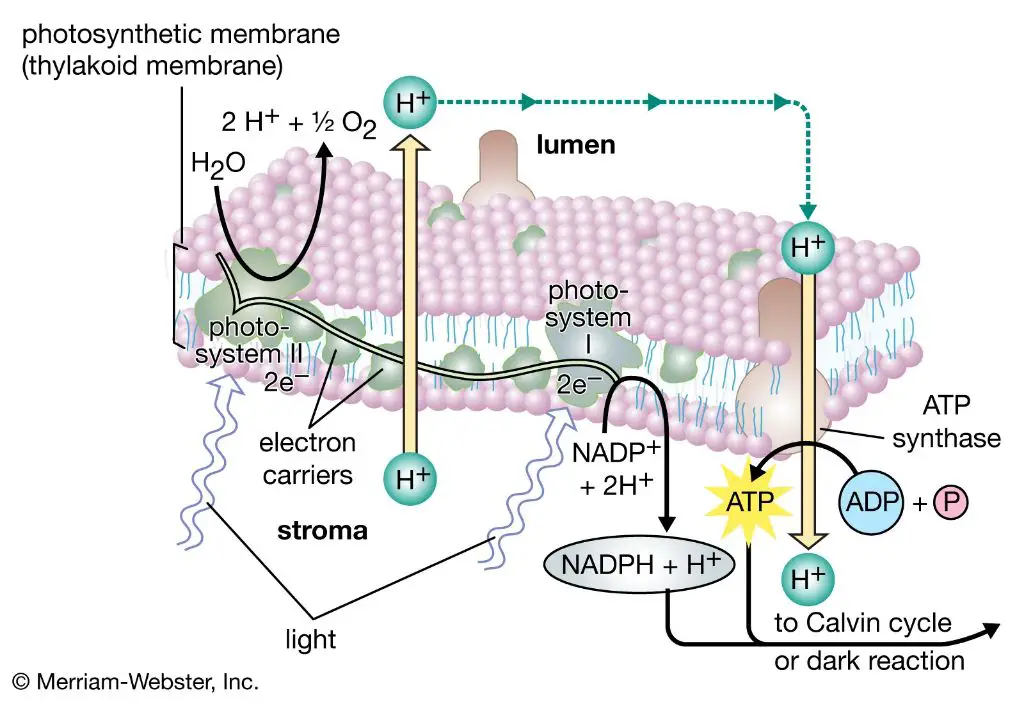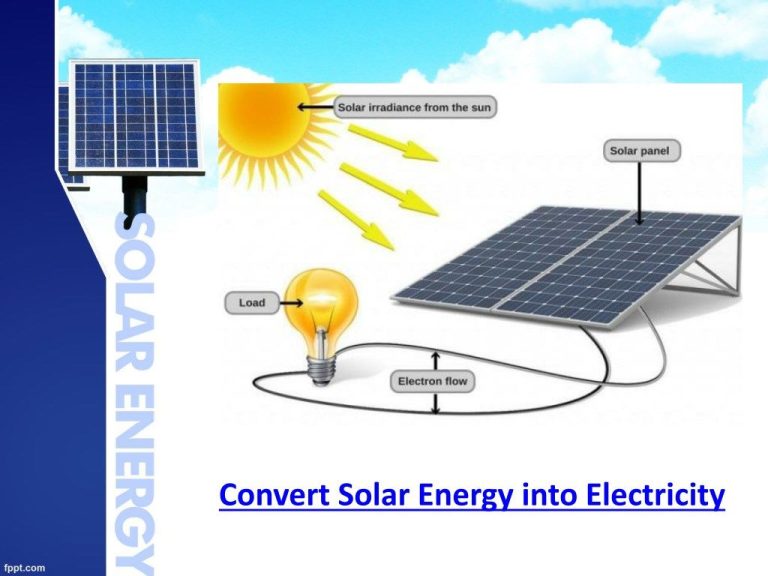What Is The Reaction That Absorbs Solar Energy?
Photosynthesis is the process by which plants, algae, and some bacteria harness sunlight, carbon dioxide, and water to produce carbohydrates and oxygen. It is one of the most important chemical reactions on Earth, providing the primary source of energy and oxygen in the atmosphere. Photosynthesis gives energy to nearly all living things directly or indirectly.
The word “photosynthesis” comes from the Greek words “photo,” meaning light, and “synthesis,” meaning putting together. During photosynthesis, plants convert the sun’s light energy into chemical energy that is stored in the bonds of carbohydrate molecules. This energy is used to fuel plant growth and metabolism.
Photosynthesis is crucial to life because it provides two main products: carbohydrates and oxygen. The carbohydrates synthesized during photosynthesis provide energy and building material for plants and for the animals and humans that rely on plants for food. The oxygen released is generated as a byproduct and enables aerobic respiration in animals and humans.
Overview of Photosynthesis
Photosynthesis is the process plants and other organisms use to convert sunlight into chemical energy in the form of glucose. This process occurs in chloroplasts, specialized organelles found in plant cells and the cells of some bacteria and algae. During photosynthesis, chlorophyll and other pigments absorb sunlight and use its energy to split water molecules into hydrogen and oxygen. The hydrogen joins with carbon dioxide to produce glucose, while the oxygen is released as a byproduct.
Photosynthesis is vital to life on Earth. It replenishes the atmosphere with oxygen, provides food and energy to nearly all living organisms, and supplies the fuel and organic matter needed to sustain ecosystems. Without photosynthesis, complex life would not exist.
The Light Reactions
The light reactions of photosynthesis absorb light energy and convert it into chemical energy in the form of NADPH and ATP. This process takes place in the thylakoid membranes within chloroplasts.

When a pigment molecule such as chlorophyll absorbs light, an electron in the molecule gets excited to a higher energy state. The excited electron is transferred to an electron acceptor molecule, leaving behind a “hole” in the original pigment molecule. This creates a separation of charge across the thylakoid membrane.
The electron passes through an electron transport chain, similar to cellular respiration. As the electron passes through the chain, it provides energy to pump hydrogen ions (H+) across the thylakoid membrane into the thylakoid interior space, creating a proton gradient. This proton gradient powers ATP synthase to produce ATP.
The electron that gets boosted to a higher energy level in chlorophyll ends up reducing NADP+ to NADPH at the end of the electron transport chain. Meanwhile, the “hole” in chlorophyll is filled by taking electrons from water, splitting water molecules and releasing oxygen as a byproduct.
In summary, light energy excites electrons in chlorophyll which leads to a flow of electrons and hydrogen ions across the thylakoid membrane. This creates NADPH and ATP, which store the energy from light in chemical bonds. Water is split in the process, releasing oxygen gas.
The Calvin Cycle
The Calvin cycle is the second stage of photosynthesis, where the chemical energy produced during the light reactions is utilized to fix carbon dioxide into organic compounds. This process was discovered by scientist Melvin Calvin, and so it is named the “Calvin cycle.”
In the Calvin cycle, the carbon dioxide that enters a plant through the stomata is incorporated into a 5-carbon sugar called RuBP (ribulose bisphosphate). An enzyme called RuBisCO facilitates this fixation by catalyzing the reaction between RuBP and carbon dioxide. This forms an unstable 6-carbon intermediate, which immediately splits into two 3-carbon chains called 3-phosphoglycerate or 3-PGA.
These 3-carbon chains are then reduced by receiving electrons, converting them into a more stable 3-carbon sugar called G3P (glyceraldehyde 3-phosphate). For the net synthesis of one G3P molecule, the Calvin cycle must take place three times, using three molecules of RuBP and three molecules of carbon dioxide. Several ATP and NADPH molecules from the light reactions provide the necessary energy and electrons.
Some of the G3P exits the cycle to contribute to glucose synthesis and other metabolic processes. But most is recycled to regenerate RuBP so that the plant has a constant supply. This recycling allows the fixation reactions to continue indefinitely.
In summary, the Calvin cycle utilizes the ATP and NADPH from light reactions to power the conversion of carbon dioxide into organic compounds like G3P. This regenerative process allows plants to synthesize carbohydrates and sugars from carbon dioxide, water, and sunlight.
Where Photosynthesis Occurs
Photosynthesis takes place primarily in the leaves of plants. The leaves contain many green pigments called chlorophyll which give leaves their characteristic green color. Within plant leaves are small organelles called chloroplasts. Chloroplasts contain the chlorophyll pigments that capture light energy from the sun. The chloroplasts are the sites of photosynthesis within plant cells.
In addition to leaves, photosynthesis can also take place in the stems and other green parts of a plant. Any plant tissue that contains chlorophyll has the potential to carry out photosynthesis. The stems, flowers, fruits, and seeds of some plants also contain chlorophyll and can produce their own energy through photosynthesis.
Overall, the leaves are the primary location where photosynthesis takes place in most plants. The broad, flat shape of leaves maximizes light capture and gas exchange for photosynthesis. Within the leaves, thousands of chloroplasts in the cells absorb light energy and convert it into chemical energy during photosynthesis.
The Inputs and Outputs
Photosynthesis requires three main inputs in order to occur: water, carbon dioxide, and light. During the light reactions, water is split to provide electrons, hydrogen ions, and oxygen. Water serves as the electron donor to replace those lost from chlorophyll. The oxygen gas produced is released as a byproduct. Carbon dioxide is fixed and incorporated into carbohydrates during the Calvin cycle. The light energy from the sun provides the energy needed to drive the reaction.
The main outputs of photosynthesis are oxygen and carbohydrates. Oxygen gas (O2) is generated during the light reactions and released into the atmosphere. Carbohydrates, including glucose (C6H12O6), are synthesized during the Calvin cycle from carbon dioxide and used for growth, energy storage, and building biomass.
Photosynthetic Organisms
Photosynthesis occurs in many different organisms, primarily plants, algae and some bacteria. The most well-known photosynthetic organisms are plants. Plants contain special structures called chloroplasts which contain the chlorophyll pigment that captures light energy. There are over 300,000 species of plants that utilize photosynthesis. Plants form the foundation of the food chain and provide nutrition for other organisms.
Algae are another diverse group of organisms that perform photosynthesis. Algae live in aquatic environments like oceans, lakes and rivers. There are over 30,000 known species of algae. Algae include large multicellular organisms like kelp as well as microscopic single-celled organisms like phytoplankton. Algae are responsible for producing over half of the photosynthesis on Earth.
Some bacteria also carry out photosynthesis. Cyanobacteria are a phylum of bacteria that obtain energy through photosynthesis. They are one of the most primitive organisms on Earth and were the first to evolve oxygenic photosynthesis, producing oxygen as a byproduct. Cyanobacteria are abundant in aquatic and terrestrial environments.
Photosynthetic organisms provide the energy and oxygen that sustain virtually all life on Earth. Their ability to capture the sun’s energy brought about a transformation of early Earth’s atmosphere and made complex life possible.
Evolution of Photosynthesis
Photosynthesis has evolved over billions of years into the complex process we know today. The earliest organisms likely used chemicals like hydrogen sulfide or iron ions instead of water to obtain electrons. Somewhere around 3 billion years ago, cyanobacteria evolved the ability to split water molecules for electrons, marking a turning point in evolution. Water was much more abundant than other chemical sources of electrons, so organisms with photosynthesis had a huge advantage. Using water also produced oxygen as a byproduct. The buildup of oxygen in the atmosphere from photosynthesis eventually allowed aerobic respiration and complex life to evolve.
Over time, different photosynthetic pigments evolved in plants, allowing photosynthesis to occur in different light wavelengths. Chlorophylls optimized light capture in the visible range, carotenoids protected against photodamage, and phycobilins expanded light absorption into green and yellow wavelengths. The two types of photosystems we see today also evolved independently before being combined into Z-scheme photosynthesis, which made the process more efficient by preventing backflows of electrons and protons.
Later, some organisms formed symbiotic relationships where photosynthetic algae or bacteria lived inside a host, eventually becoming the chloroplasts in plant cells. This endosymbiotic origin of chloroplasts allowed eukaryotic organisms to perform photosynthesis. The evolution of C4 and CAM photosynthesis in plants also helped adaptation to dry, high light environments. Even now, photosynthesis continues to evolve as plants adapt to new conditions.
Importance to Life
Photosynthesis is the basis of the sustenance of nearly all life on Earth. By harnessing the sun’s energy to convert carbon dioxide and water into carbohydrates and oxygen, photosynthetic organisms provide the energy and oxygen that supports virtually every ecosystem on the planet.
The carbohydrates produced through photosynthesis are used by the photosynthetic organisms for energy, growth, and reproduction. Any excess carbohydrates are stored or used by other organisms as an energy source. This forms the foundation of most food chains and webs.
The oxygen produced through photosynthesis enabled the evolution of aerobic respiration and complex multicellular life. The atmospheric oxygen humans and other animals breathe to survive originated from photosynthetic organisms. Even today, over half the oxygen in the atmosphere is produced by marine organisms through photosynthesis.
By removing carbon dioxide from the atmosphere through photosynthesis, photosynthetic organisms help regulate Earth’s climate and make conditions hospitable for life. The burial of organic matter also removes carbon from the environment, locking it away in fossil fuel deposits.
In short, photosynthesis powers life by harnessing the sun’s energy to provide food and oxygen. It sustains ecosystems and makes Earth habitable for countless species. Without photosynthesis, complex life likely could not exist.
Recent Advances
Photosynthesis research remains an active area of scientific investigation. Some recent advances include:
Improved understanding of photoprotection mechanisms. Plants utilize various strategies to prevent damage from excess sunlight, such as non-photochemical quenching and leaf movements to avoid light exposure. New discoveries into how these protective mechanisms work may lead to engineered crop plants better able to cope with high-light stress.
Artificial photosynthesis. Significant progress has been made in designing biohybrid and biomimetic systems that mimic natural photosynthesis to produce fuels and chemicals. For example, coupling semiconductors like titanium dioxide with catalysts can split water into oxygen and hydrogen fuel. Such artificial systems could offer clean, renewable energy solutions.
Enhanced photosynthetic efficiency. Through genetic engineering and synthetic biology, researchers are working to improve the photosynthetic efficiency of plants and algae. This includes introducing pathways from more efficient photosynthetic organisms, modifying light-harvesting systems, and enhancing carbon fixation. Such enhanced efficiency could boost agricultural productivity and yields.
Discovery of new photoreceptors. Our understanding of the light-sensing mechanisms in photosynthesis continues to grow. Recent discoveries have identified new classes of photoreceptors like phototropin and UV-B photoreceptors that fine-tune various aspects of the photosynthetic process.
Elucidating the evolution of photosynthesis. Advances in genomic sequencing have enabled scientists to gain insights into how various photosynthetic mechanisms evolved over billions of years. This further reveals the complex orchestration and optimizations that exist in modern photosynthetic organisms.






